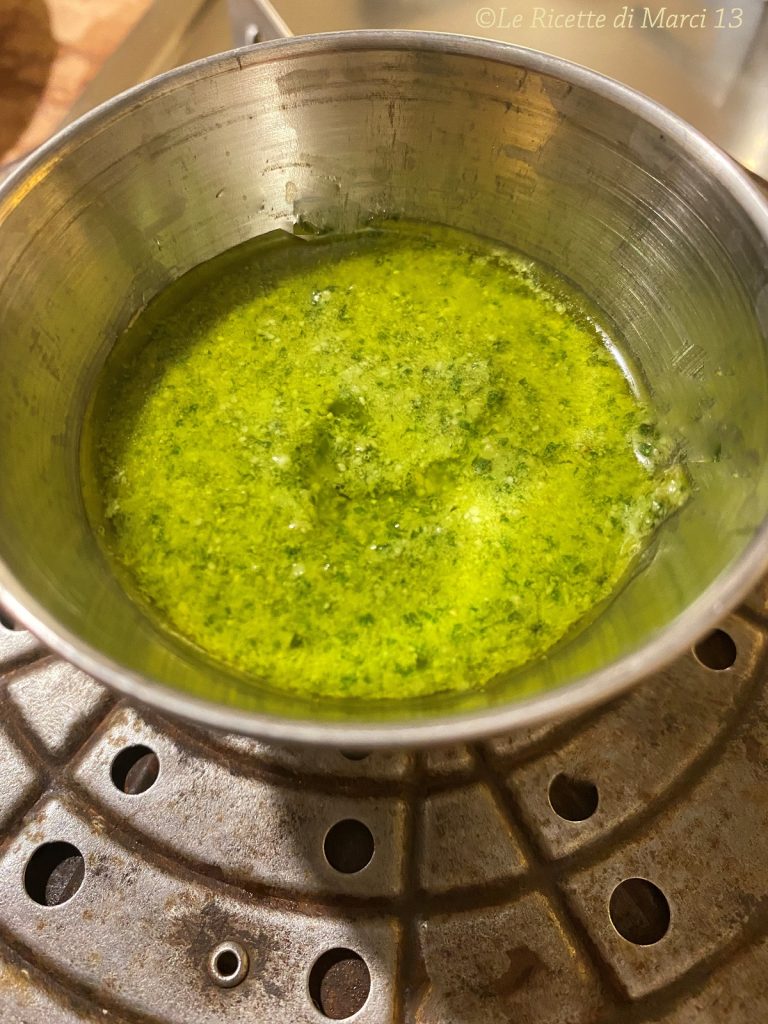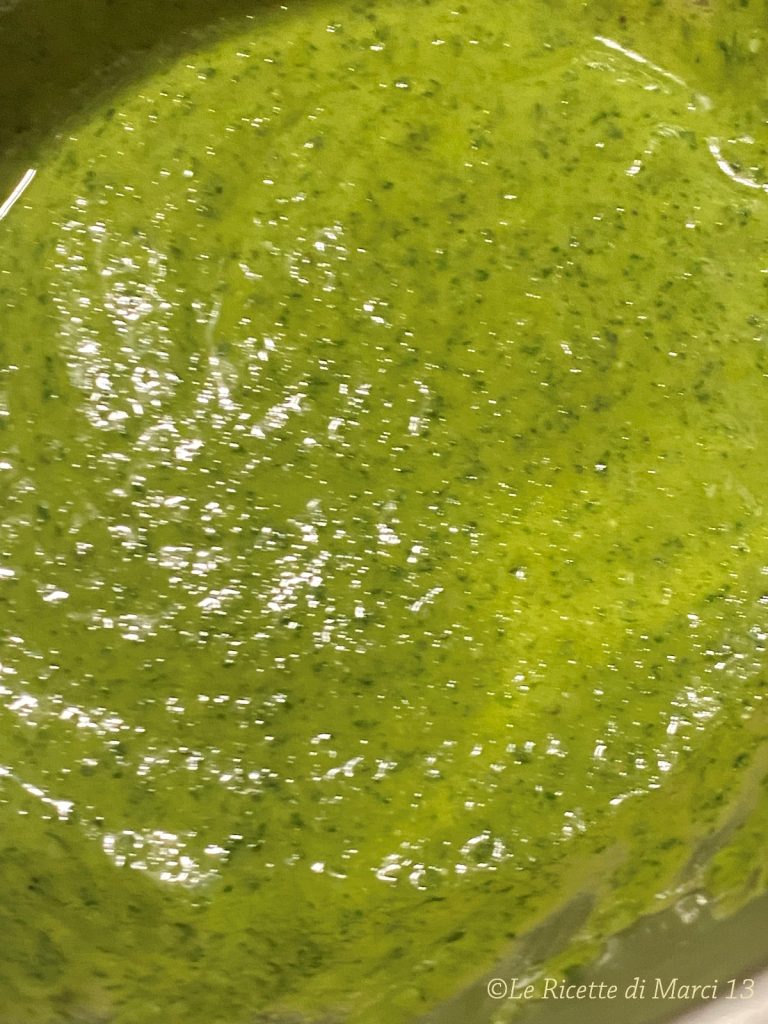Perfect Genovese Pesto
Pesto is a traditional sauce from Ligurian cuisine, made with basil, garlic, pine nuts, pecorino, parmesan, and extra virgin olive oil, gluten-free.
It’s ideal for seasoning fresh trofie (to which you can add boiled green beans and potatoes), trenette, gnocchi, vegetable couscous, lasagna (in this case, you can create layers of pesto, béchamel, mozzarella, and grated parmesan).
It’s an easy and quick condiment to prepare, as long as you follow my tips and tricks, especially if you’re not using the typical marble mortar as I did, but using a mixer or electric blender (NO immersion blender, it incorporates too much air):
I) Wash the basil leaves very gently and let them dry perfectly: because if the leaves get wrinkled or broken, they will turn black and make the pesto taste bitter.
II) At least one hour before using the blender, put it in the refrigerator with the blades and all ingredients to be used (always to prevent the pesto from darkening)
III) Add walnuts (or unsalted cashews, optional) + lemon juice, to avoid the bitter taste.
IV) Pesto is NOT heated in a pot; it is added at room temperature to the hot dish to be seasoned (pasta, gnocchi, etc.).
If you’re looking for easy and quick recipes (sweet or savory) click on my Special: “Easy and Quick Recipes“.
If you’re looking for light recipes (sweet or savory), click on my Special: “Light Recipes …but Tasty!“
If you’re looking for summer recipes (sweet or savory), click on my: “Summer Special“.
You might also be interested in:
- Baked Fusilli with Potato and Walnut Pesto, and Provola. Very Easy Rustic Recipe.
- Mega Lemon Sandwich with Zucchini and Almond Pesto
- Spaghetti with Chili, Sun-dried Tomatoes, and Crumbled Tarallo
- Tagliolini with Lemon, Cream, and Prosciutto Crudo
- Assassina Spaghetti Original Recipe, Easy Step by Step.

- Difficulty: Very Easy
- Cost: Medium
- Preparation time: 5 Minutes
- Portions: 6 People
- Cooking methods: No Cooking
- Cuisine: Regional Italian
- Region: Liguria
- Seasonality: All Seasons, Spring, Summer
- Energy 464.45 (Kcal)
- Carbohydrates 3.29 (g) of which sugars 0.52 (g)
- Proteins 8.79 (g)
- Fat 48.35 (g) of which saturated 9.54 (g)of which unsaturated 4.30 (g)
- Fibers 0.87 (g)
- Sodium 1,078.51 (mg)
Indicative values for a portion of 50 g processed in an automated way starting from the nutritional information available on the CREA* and FoodData Central** databases. It is not food and / or nutritional advice.
* CREATES Food and Nutrition Research Center: https://www.crea.gov.it/alimenti-e-nutrizione https://www.alimentinutrizione.it ** U.S. Department of Agriculture, Agricultural Research Service. FoodData Central, 2019. https://fdc.nal.usda.gov
Ingredients for Perfect Genovese Pesto
- 3.5 oz basil (preferably PDO)
- 0.7 oz garlic (preferably from Vessalico)
- 1.75 oz pine nuts (loose quality (not in trays))
- 4 walnuts (or 5-6 unsalted cashews, optional)
- 2.1 oz Parmigiano Reggiano PDO (I use Grana)
- 1.05 oz pecorino sardo (optional (I don't use it))
- 5.3 oz extra virgin olive oil (quality, preferably Ligurian)
- 1.05 oz coarse salt (preferably, coarse sea salt)
- 0.25 oz lemon juice (optional)
Tools
- Bowl
- Mixer
- Knife
- Container
Steps for Perfect Genovese Pesto
First – If you’re not using the mortar and decide on the mixer/blender – an hour before starting, place the blades and container of the mixer (or blender) in the refrigerator. A trick, as mentioned above, to avoid overheating the pesto. Also, keep all the ingredients in the fridge.
Then wash the basil leaves very gently and let them dry well on a clean towel (make sure to remove all the basil stems).

After the indicated cooling time, first, mash with the mixer/blender (or mortar) the peeled garlic cloves (about 0.7 oz) and the coarse salt (about 1.05 oz).
Then add the pine nuts and walnuts (or cashews, optional), grated cheeses (I only use Grana), and continue blending intermittently to avoid overheating the blades (crucial).
Finally, the basil leaves, the oil, in a trickle, little by little, which should cover the basil leaves, and the lemon juice, always giving the engine brief pulses, followed by equally brief pauses.

The time you spend blending everything (if not using a mortar) is crucial; it must be the shortest possible, only in this way can you avoid the oxidation and bitterness of the basil and other ingredients. The secret lies in operating the mixer/blender at the lowest speed and blending in short bursts with pauses to prevent the temperature of the mixture from rising.
At this point, your pesto is ready BUT remember to add it at room temperature to your hot dishes to be seasoned (pasta, gnocchi, etc.)
The pesto DOES NOT heat in a pot, otherwise it becomes bitter.

You can store the pesto in the refrigerator for up to 7 days covered with olive oil on the surface in sterilized jars. Alternatively, you can put it in the freezer (always in sterilized jars) and then thaw it at room temperature.
Notes and Tips
Why can pesto become bitter? Read here.
If you want to prepare it in quantity and freeze it, or simply store it in the fridge, remember, once poured into jars, to cover the surface of the pesto with a layer of oil. It will prevent oxidation.
If you don’t like garlic, just omit this ingredient.
Shopping Tips!!!
Ideal for preparing pesto is this marble mortar with pestle, available on Amazon at a special price.
I prepared the pesto using my Braun MultiQuick 7 Minipimer, which you can purchase at a special price by clicking HERE
Read my review for GialloZafferano on the Minipimer “Braun MQ9045 MultiQuick 9“.
Read my review for GialloZafferano on the Minipimer “Braun MQ9045 MultiQuick 9“.

